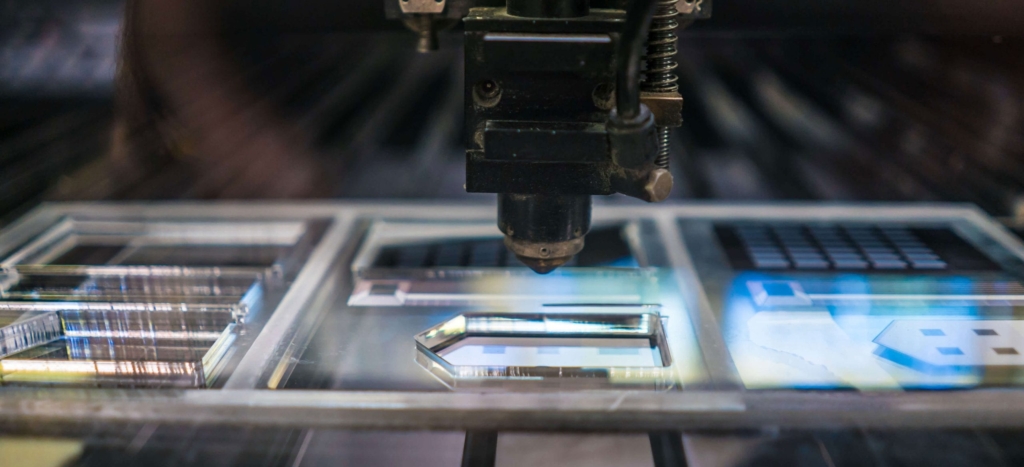Acrylic vs Polycarbonate
Table of Contents
Acrylic and polycarbonate are two of the most popular clear plastics, and are often seen as direct competitors.
There are, however, very distinct differences in each material that make for more appropriate use in their own jobs. So, what are the differences?

Make-up
Firstly, both materials are formed in a different manner. Acrylic plastic polymers are formed in a process called bulk polymerisation. With thickness and shape of the project considered, either batch cell or continuous method processing is used to form the plastic.
Polycarbonate differs from this, composed of Bisphenol A (BPA) and Phosgene. There are a few different ways to create polycarbonate, one such method being free radical polymerisation. The use of BPA in polycarbonate is home to much debate surrounding the toxicity of the chemical. Some research has shown exposure to BPA has cause for health concerns.
Properties
Both plastics are noted for their light weight qualities, half the weight of glass but with a much stronger impact resistance.
Acrylic is the stiffer of the two plastics but also proves to be more scratch resistant than polycarbonate. While both plastics appear clear, polycarbonate falls behind acrylic in translucence. Particularly when working with thicker sections, acrylic proves to present much higher clarity. This makes acrylic the more logical choice for design projects, awards, and tombstones. Acrylic is often favoured in projects that do not require strength, and where the visuals are key to the design.
Polycarbonate excels in its strength. While acrylic has 10 times the impact resistance of glass, polycarbonate shows 30 times. This makes the plastic virtually indestructible and therefore is often prioritised in the likes of construction projects where a greater withstanding is required. Additionally, it is far more flexible than acrylic, meaning it can endure wear and tear.
In terms of heat, the use of acrylic isn’t recommended in areas close to heat or fire, ranked as Class 3 in terms of fire resistance. Polycarbonate can withstand these temperatures, and is Class 1. While both plastics may expand and contract with changes in temperature, they will both withstand weather changes and will not permanently shrink over time.
Machining and Handling
Both plastics can be cut with conventional tooling, but acrylic cuts easier and offers more precision in this, this is especially beneficial when working with sheet. Particularly with electrical tooling, acrylic works with greater ease and noticeably less resistance. Additionally, if requiring a glue joint, acrylic will offer a cleaner finish. The exception to this is when drilling is needed, where polycarbonate can be safely drilled with a standard bit and 99% of the time suffers no damage. Acrylic, however, will withstand drilling but becomes more likely to break the closer you drill to corners.
Where acrylic truly stands out in terms of machining and handling, is its ability to be polished. This has two key benefits to a project. First, the finished product will ensure a high shine is obtained. Secondly, and perhaps most importantly, any scratches that occur subsequently down the line, are able to be polished away and repaired. Unlike acrylic, polycarbonate cannot be polished, meaning any scratches obtained cannot be repaired.
Colour and Clarity
Both acrylic and polycarbonate offer a better clarity than glass, letting in more light. Acrylic has a light transmittance of 92%, while polycarbonate offers a light transmittance of 88%. Therefore, acrylic is marginally clearer than polycarbonate, and is also UV resistant. This UV resistance is pivotal in longstanding pieces, as polycarbonate, that is not UV resistant, develops a yellow hue over time, whereas acrylic holds its colour and clarity. Furthermore, where damages or clouding occurs with acrylic, the piece is able to be polished to its original state.
In terms of colour, acrylic is available in a bespoke and varied colour palette. Here at Midton, we have the ability to Pantone match our acrylic to fit your vision or company branding. Using this match, we have the ability to offer this tint in whatever translucence your project requires. While polycarbonate is available in a standard broad range of colours, there is a far more limited variety available.
Cost
Acrylic is a cheaper alternative to polycarbonate, with polycarbonate costing about 35% more.
Our Verdict
Through our work here at Midton, we have worked and experimented with both acrylic and polycarbonate. In our experience, acrylic is more suited to our line of work. Both are well-suited to individual needs, but acrylic triumphs for small batch design projects. With UV resistance, a large spectrum of colour options, and the ability to be polished, acrylic suits the needs of our clients.

5 Questions you may have about deal toys
The world of deal toys and financial tombstones can be confusing, from terminology to presentation.…

One Tree Planted: Guatemala, San Marcos Mangrove Restoration
Having launched our tree planting scheme in October, and investing in our first project in November, we…
